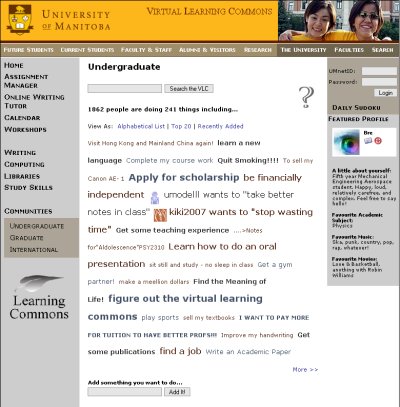MPOW is currently renovating a couple of floors of the library to make a Learning Common. We’re creating an area with lots of bench space and PCs, where students can gather and access services in the one spot – like library materials and staff, the First Year co-ordinator, IT service desk, print shop and our Teaching and Learning staff. Part of the building will be open 24/7.
I’ve been chirping on about how our online space should match the attitudes and philosophy of the new physical space, but didn’t have a clear picture of what I meant. Until I read a post on Linda Bedwell’s “Five Weeks to a Social Library” course blog. She linked to the University of Manitoba Virtual Learning Commons. “Aha!” said I, and “aha” again.
They have made a mini social network, based around a tag cloud of “what I’d like to do” suggestions similar to 43 things. A random profile is featured to the right. There is a Flickr stream on the bottom of the page (not shown).
I wonder how moderated the “something you want to do” list is. Surely their thoughts are more pop culturally, hormonally and substance driven than that? But maybe, just maybe…these kids can read and understand the social space and have set an appropriate norm without intervention.
This page would have kept me coming back when I was at Uni. Heck, I came back to read the “feedback to the library” suggestions and answers on paper cards pinned in the library lobby when I was a student. It let me know that other people were thinking the same as me, and having the same experience of Uni.
Just like a physical learning common, where a community of learners socialise as they learn but have access to expert university support when they need it, the sidebar provides links to several university services to support their learning. Writing, computing, libraries, study skills, asssignment management, online tutor – all the things we aim to have in our new physical space are there online.
UPDATE: 20 March 2007. I’ve just discovered that the software that generated this is Open Source and available on Sourceforge.

